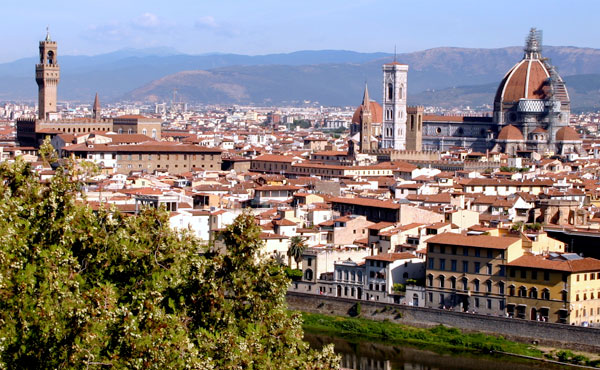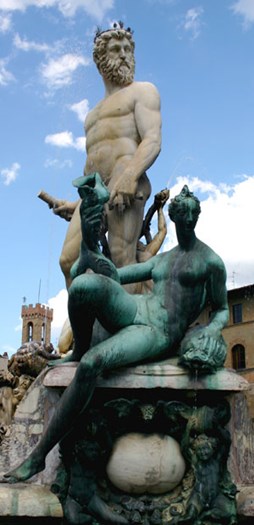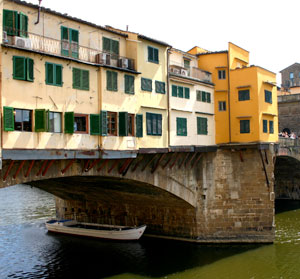FLORENCE, ITALY – The middle aged British couple beside us in the open air restaurant across from this city’s famed 13th century cathedral, or Duomo, were celebrating their 30th wedding anniversary with a train trip through Italy.
“We just came from Venice,” our neighbors told us. “Venice is beautiful but nothing beats this city. This is like a box of chocolates. Everything is so good!”
Florence doesn’t get as much publicity as Venice, Rome or Milan but it may be the most satisfying place in Italy to visit.
The Tuscan city of terra cotta roofs is where some of Italy’s greatest historical characters once lived. And they left us amazing reminders of their stay here, starting with the Duomo, the massive church that took from the 13th to the 19th century to totally complete.

Above: Florence spreads out into the majestic Tuscan hills.
A stunning structure made of green and white marble, The Duomo is the third largest in the world, behind St. Peter's in Rome and St. Paul's in London. It stretches 153 meters and was designed to hold 30,000 worshippers. However, because it’s empty of pews "to help the flow of visitors" its stone cold floors and walls make it appear unwelcoming.
The cathedral's octagonal dome is decorated with some of the world's greatest frescos, but few are willing to climb the 463 stone steps it takes to get to the top.
The Bell Tower that sits beside the great cathedral is considered Florence’s most important building, if you can believe that. Bell towers in Tuscan towns and cities hold a special place because they were always the main target of invading armies. Capture the bell tower and you controlled the city. Locals tell you many people lost their lives defending Florence’s Bell Tower and that’s why its held in such high stature.
As impressive as the Duomo is, especially its unique façade, it’s not Florence’s most impressive church. We bestow that honor on the much smaller but far more interesting Basilica di Santa Croce, a short walk away from the Duomo.
Santa Croce is where the remains of Michelangelo and Galileo now rest beneath its cold, black marble floor. The basilica is filled with wonderful stained glass windows, great columns, a beautiful courtyard garden and the Italian version of the Statue of Liberty.
"That statue," a guide told us "is the one that inspired the French version that was later presented to the United States."

Above: Florence is a cultural oasis.
Outside Santa Croce is the square where a crude form of soccer was first played back in 1518. Each year the city holds a reenactment of the first game where 27 players, not the nine of today’s game, make up each team.
Michelangelo is held in saint-like status here because his works put the city on Italy’s cultural map. He worked in Florence or Firenze as the locals call it, most of his life until his death at the age of 89.
Many of Michelangelo’s greatest works, including his most famous statue, David, now can be seen at the city’s impressive art museum, the Gallerie dell' Accademia.
Ironically, the first great work when you walk into the marble lined building is not one of Michelangelo’s but rather one designed by sculptor Giovanni Bologna - the "Rape of the Sabine Women". What a great introduction!
Bologna chiseled his masterpiece in 1583 and it quickly became legend because it was the first statue featuring three bodies all carved from the same piece of marble. It’s a haunting piece that stands over 13 feet high and you’ll find it hard to take your eyes off it.
The hallway leading to David is crammed with some of Michelangelo's other great works but none impresses quite like the massive naked figure that stands over 30 feet high. The most striking features about David are his hands and nose - both totally out of proportion to the rest of his body.
There’s an interesting urban legend attached to the nose. Apparently, when David was unveiled to the local governor, he complained the nose was too large and ordered Michelangelo to fix it. The temperamental artist grabbed a hand full of sand without anyone noticing, climbed to the top and pretended to chisel the nose down, dropping bits of sand to make the governor think he was following orders. When finished, the governor applauded the great artist and con man.
While David was only 12 when he downed Goliath, the statue resembles a man in his mid-20s. Not only that, the model used in the making of David was probably dead, according to a museum guide. "Michelangelo preferred to use corpses as his models," we were told.

Above: The famous Ponte Vecchio.
A short walk away from the museum is Florence’s most stunning square, Piazza della Signoria, where David stood outdoors for over 300 years. Some of the city’s greatest art treasures are located in the great square, including: the "bronze equestrian statue of Cosimo I" by Giambologna from 1594; The Fountain of Neptune by Bartolomeo Ammannati, 1575; "The Lion", referred to as "il Marzocco" with a copy of the "Florentine Lily", originally made by Donatello; "Judith and Holofernes" by Donatello (copy); "Hercules and Cacus", by Bandinelli, 1533; and the most impressive for our liking, Benvenuto Cellini's statue Perseus With the Head of Medusa. There’s also a small replica of David in the square.
There are many other highlights to Florence, which held the honor of being Italy’s temporary capital in the 1700s. Reminders of that era can be found everywhere - the Porta Romana, constructed by Roman legions; the great wall that rings the old city; the Gate of the Cross, located in one of Florence's beautiful parks; and other great piazzas - some smaller than others but all jammed with statues and each more beautiful than the last.
The city’s lovely tree-lined boulevards are bordered by pastel-colored villas, and named after the famous residents, including Galileo and Michelangelo.
The city is ringed by beautiful Tuscan hills and several rivers run through it, the most important being the Arno, which the famed Ponte Vecchio bridge crosses. The colorful bridge is one of the most photographed landmarks in Florence but the jewelry vendors who occupy every inch of the structure with the shops built into it, ruin the atmosphere.
Other highlights you should seek out in Venice are:
- The English Cemetery – the British held great influence over Florence at one time – where the body of English poet Elizabeth Barrett Browning now rests;
- The city's botanical garden, which dates back to 1562;
- Republic Square which dates back to the time the city was founded in 59 BC;
- The city’s famous leather shops – the main industry here for centuries;
- Great shopping streets where the latest fashions from Milan and Rome are displayed.
The wonderful thing about compact Florence is that all the best tourist attractions are located in an area covering less than one square mile.
The city is also surrounded by history. For example, just outside Florence you’ll find Vinci, the 1452 birthplace of Leonardo Da Vinci, who has been put back in the spotlight thanks to the movie and book, The Da Vinci Code. Florence is a city that must be seen to be believed because just like a box of chocolates, it’s full of sweet surprises.